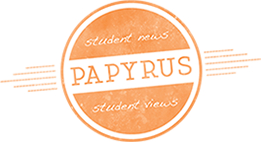Written by Dylan Deppe. Media by Joey Unger.
Symbols are everywhere. They can be on flags waving in the air, smacked on the back of a car; they could be tattooed on your body, or even be the memes you and your best buds like watching dank compilations of. Usually, symbols aren’t noticed until they are used or associated with something that is bad. But in a culture that is becoming much more image-based, an understanding of symbols and symbolism can surely help one understand the nuances of our increasingly visual world.

Genevieve von Petzinger, a speaker for TED Talks, says, “There are three main types of communication: spoken, gestural, and graphic communication,” while making the point that the first two require direct contact to work. In her TED Talk on ancient symbols, she argues that recurring symbols in multiple caves from different time periods point to the importance of symbols in ancient culture.
These crude symbols eventually became the pictographic forms of language that ancient societies were built off of, and were the foundations of our modern written language system. Even today, modern symbols are recognized and understood by millions of people across the world.

While many claim that we are currently living in an era of text-based language, our heightened used of things like emojis seems to say otherwise. Shigetaka Kurita, the man credited with creating the emoji, has said, “Japanese TV weather forecasts have always included pictures or symbols to describe the weather—for example, a picture of the sun meant ‘sunny’. I’d rather see a picture of the sun, instead of a text saying ‘fine.’”
Many people claim that the continual use of image-based communication is bad and leading to a mass mental-degradation for future generations. With our heavily-saturated media world, where we’re bombarded by text on the news, in Facebook, in emails, with homework, in bills, and from your overly-clingy beau, I don’t see how it is such a bad thing to communicate single ideas with just pictures.
Emojis are a simple way to show and not tell in the realm of social media communication. Any college-level entry English class will tell you that showing is good and that telling is bad in your most of your writing. That is probably the fundamental appeal of superheroes and comic books in this day and age. Comic books and graphic novels can do in one panel what traditional novels usually spend anywhere from a paragraph to a couple of pages to do, and that’s because showing a drawing of something is easier than trying to say with words what an object or event is.
Superheroes themselves represent the apotheosis of the visual medium from which they sprang. Superheroes, especially the DC heroes, are often represented by the symbols worn on their suits. These symbols don’t just represent their physicality and presence, but also their idols and motives. Superman’s family crest is the epitome of this; in the mythos, the logo is the Kryptonian symbol of hope that winds like a river, in the shape of our letter S, meant to show how hope can come and go in a person, and inspiring hope is Superman’s biggest character trait.

Representation with symbols has also been a hallmark of mankind throughout the ages. Different clans and tribes represented themselves with family crests they adorned their flags, shields, and clothes with. These crests involved the meaning humans have instilled in shapes, colors, textures, and even animals to communicate to other clans and tribes how the family behind the crest wishes to be perceived.

This is an idea that has also carried over into flags. But, with the recent world calamities that have happened in the past couple hundred years, some of the meanings behind these symbols have been adopted by hate groups. With the adoption of symbols, flags, and even meme characters by hate groups, these visual representations have become known as symbols of the hate groups themselves. On the topic of the changing of symbolism, SideQuest bassist Jacob Kersh has said, “That’s the thing with symbols, though, they don’t really mean just what you want them to mean. They mean what society has deemed them to mean.”
Our cultural language of the West is incorporating more and more visual forms of communication than it perhaps ever has. Even the rules about how the symbols of these forms of communication work are beginning to change. Whether it’s a cave painting, a colorful flag, a superhero, or the lol emoji, symbols and symbolism have, and still do, play a large role in how humans communicate meaning with each other, and knowing your way around the block surely can’t be too bad.




























